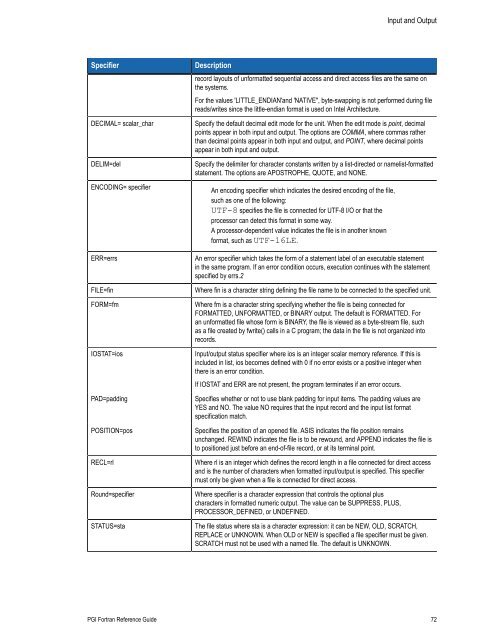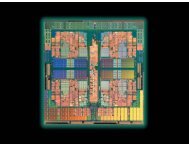PGI Fortran Reference manual - The Portland Group
PGI Fortran Reference manual - The Portland Group
PGI Fortran Reference manual - The Portland Group
- No tags were found...
Create successful ePaper yourself
Turn your PDF publications into a flip-book with our unique Google optimized e-Paper software.
Input and OutputSpecifierDECIMAL= scalar_charDELIM=delENCODING= specifierERR=errsFILE=finFORM=fmIOSTAT=iosPAD=paddingPOSITION=posRECL=rlRound=specifierSTATUS=staDescriptionrecord layouts of unformatted sequential access and direct access files are the same onthe systems.For the values 'LITTLE_ENDIAN'and 'NATIVE", byte-swapping is not performed during filereads/writes since the little-endian format is used on Intel Architecture.Specify the default decimal edit mode for the unit. When the edit mode is point, decimalpoints appear in both input and output. <strong>The</strong> options are COMMA, where commas ratherthan decimal points appear in both input and output, and POINT, where decimal pointsappear in both input and output.Specify the delimiter for character constants written by a list-directed or namelist-formattedstatement. <strong>The</strong> options are APOSTROPHE, QUOTE, and NONE.An encoding specifier which indicates the desired encoding of the file,such as one of the following:UTF-8 specifies the file is connected for UTF-8 I/O or that theprocessor can detect this format in some way.A processor-dependent value indicates the file is in another knownformat, such as UTF-16LE.An error specifier which takes the form of a statement label of an executable statementin the same program. If an error condition occurs, execution continues with the statementspecified by errs.2Where fin is a character string defining the file name to be connected to the specified unit.Where fm is a character string specifying whether the file is being connected forFORMATTED, UNFORMATTED, or BINARY output. <strong>The</strong> default is FORMATTED. Foran unformatted file whose form is BINARY, the file is viewed as a byte-stream file, suchas a file created by fwrite() calls in a C program; the data in the file is not organized intorecords.Input/output status specifier where ios is an integer scalar memory reference. If this isincluded in list, ios becomes defined with 0 if no error exists or a positive integer whenthere is an error condition.If IOSTAT and ERR are not present, the program terminates if an error occurs.Specifies whether or not to use blank padding for input items. <strong>The</strong> padding values areYES and NO. <strong>The</strong> value NO requires that the input record and the input list formatspecification match.Specifies the position of an opened file. ASIS indicates the file position remainsunchanged. REWIND indicates the file is to be rewound, and APPEND indicates the file isto positioned just before an end-of-file record, or at its terminal point.Where rl is an integer which defines the record length in a file connected for direct accessand is the number of characters when formatted input/output is specified. This specifiermust only be given when a file is connected for direct access.Where specifier is a character expression that controls the optional pluscharacters in formatted numeric output. <strong>The</strong> value can be SUPPRESS, PLUS,PROCESSOR_DEFINED, or UNDEFINED.<strong>The</strong> file status where sta is a character expression: it can be NEW, OLD, SCRATCH,REPLACE or UNKNOWN. When OLD or NEW is specified a file specifier must be given.SCRATCH must not be used with a named file. <strong>The</strong> default is UNKNOWN.<strong>PGI</strong> <strong>Fortran</strong> <strong>Reference</strong> Guide 72
















